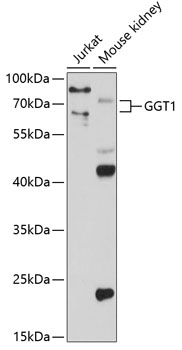-
Product Name
GGT1 Polyclonal Antibody
- Documents
-
Description
Polyclonal antibody to GGT1
-
Tested applications
WB, IHC
-
Species reactivity
Human, Mouse, Rat
-
Alternative names
GGT1 antibody; CD224 antibody; D22S672 antibody; D22S732 antibody; GGT antibody; GGT 1 antibody; GTG antibody; gamma-glutamyltransferase 1 antibody
-
Isotype
Rabbit IgG
-
Preparation
Antigen: Recombinant fusion protein containing a sequence corresponding to amino acids 370-569 of human GGT1 (NP_001027537.1).
-
Clonality
Polyclonal
-
Formulation
PBS with 0.02% sodium azide, 50% glycerol, pH7.3.
-
Storage instructions
Store at -20℃. Avoid freeze / thaw cycles.
-
Applications
WB 1:500 - 1:2000
IHC 1:50 - 1:200 -
Validations

Western blot - GGT1 Polyclonal Antibody
Western blot analysis of extracts of various cell lines, using GGT1 antibody at 1:1000 dilution.Secondary antibody: HRP Goat Anti-Rabbit IgG (H+L) at 1:10000 dilution.Lysates/proteins: 25ug per lane.Blocking buffer: 3% nonfat dry milk in TBST.Detection: ECL Enhanced Kit .Exposure time: 90s.

Immunohistochemistry - GGT1 Polyclonal Antibody
Immunohistochemistry of paraffin-embedded rat kidney using GGT1 antibody at dilution of 1:100 (40x lens).

Immunohistochemistry - GGT1 Polyclonal Antibody
Immunohistochemistry of paraffin-embedded human breast cancer using GGT1 antibody at dilution of 1:100 (40x lens).

Immunohistochemistry - GGT1 Polyclonal Antibody
Immunohistochemistry of paraffin-embedded mouse kidney using GGT1 antibody at dilution of 1:100 (40x lens).
-
Background
Cleaves the gamma-glutamyl bond of extracellular glutathione (gamma-Glu-Cys-Gly), glutathione conjugates, and other gamma-glutamyl compounds. The metabolism of glutathione releases free glutamate and the dipeptide cysteinyl-glycine, which is hydrolyzed to cysteine and glycine by dipeptidases. In the presence of high concentrations of dipeptides and some amino acids, can also catalyze a transpeptidation reaction, transferring the gamma-glutamyl moiety to an acceptor amino acid to form a new gamma-glutamyl compound. Initiates extracellular glutathione (GSH) breakdown, provides cells with a local cysteine supply and contributes to maintain intracellular GSH level. It is part of the cell antioxidant defense mechanism. Isoform 3 seems to be inactive.
Related Products / Services
Please note: All products are "FOR RESEARCH USE ONLY AND ARE NOT INTENDED FOR DIAGNOSTIC OR THERAPEUTIC USE"
